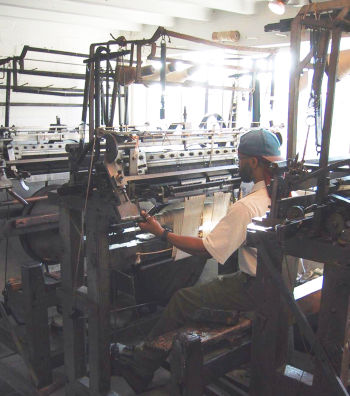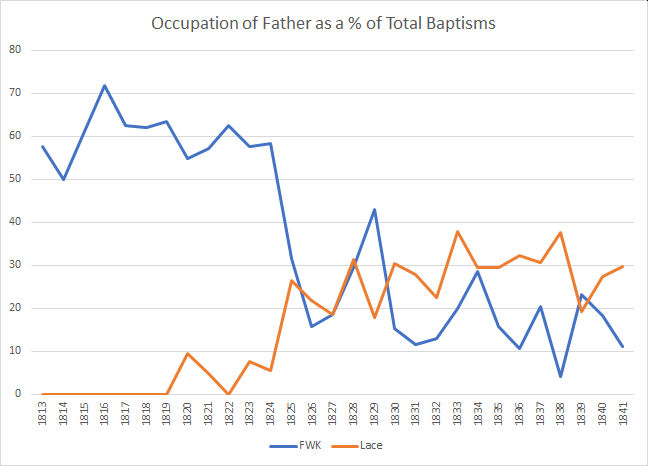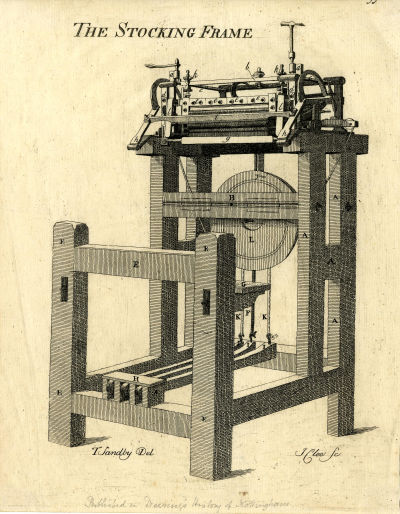|
|
| Home Topics Memorials Miscellany Transcripts References Family History Glossary Latest Beeston Blog About us | Site Search |
|
The Framework Knitting Industry -The history of stocking knitting on frames centered on the counties of Nottinghamshire, Derbyshire and Leicestershire is already well documented so it is appropriate that,
after a summary of the wider aspects of the craft and some useful references for those who wish to look at these further, we intend to focus on its impact on Beeston itself. |
|||||||||||||||||||||||||||||||||||||||||||||||||||||||||||||||||||||||||||||||||||||||||||||||||||||||||||||||||||||||||||||||||||||||||||||||||||||||||||||||||||||||||||||||||||||||||||||||||||||||||||||||||||||||||||||||||||||||||||||||||||||||||||||||||||||||||||||||||||||||||||||||||||||||||||||||||||||||||||||||||||||||||||||||||||||||||||||||||||||||||||||||||||||||||||||||||||||||||||||||||||||||||||||||||||||||||||||||||||||||||||||||||||||||||||||||||||||||||||||||||||||||||||||||||||||||||||||||||||||||||||||||||||||||||||||||||||||||||||||||||||||||||||||||||||||||||||||||||||||||||||||||||||||||||||||||||||||||||||||||||||||||||||||||||||||||||||||||||||||||||||||||||||||||||||||||||||||||||||||||||||||||||||||||||||||||||||||||||||||||||||||||||||||||||||||||||||||||||||||||||||||||||||||||||||||||||||||||||||||||||||||||||||||||||||||||||||||||||||||||||||||||||||||
| Households employed in | ||||
| Census Year | Population | Agricuture | Manufacture | Other |
| 1811 | 1,342 | 61 | 188 | 12 |
| 1821 | 1,534 | 79 | 176 | 54 |
| 1831 | 2,530 | 94 | 401 | 40 |
A note appended to the report for 1831 sheds a light on the reason for the relatively large increase in both population and 'manufacture' in the previous decade. It reads "The Parish of Beeston has increased in
population (996 persons) attributed to lace manufacture and silk mill" and begins to explaining why Beeston was quick to recover from the slump amongst the cottage-based framework knitting community. It refers to
the Silk Mill that opened in Beeston in 1826 and, despite a chequered career, provided employment, particularly for younger people, for about 75 years, a story that has already been told here
 and the early beginnings of the lace making industry that was to mature into a major industry in Beeston and is described here. Another, perhaps more
subtle factor, one that is not mentioned in the official note, although it is related, is Beeston's relatively early development of small workshops, often adjacent to cottages, which brought groups of knitters together
with the resulting economies of scale and relative flexibiity. The frameworkers museum at Ruddington, Notts (where a frame is shown in action here) which dates from 1829 is an excellent surviving example of this type of
working arrangement. In turn, the workshop concept developed into early factories, particularly in the open spaces around the village core - an advantage at Beeston that was not readily available at overcrowded Nottingham.
The even more structured factory envoronments also allowed technology changes to be introduced - something that had been a difficult option for the lone knitter in his cottage - and Beeston folk were not slow in realising
the inevitability and advantages of these changes.
and the early beginnings of the lace making industry that was to mature into a major industry in Beeston and is described here. Another, perhaps more
subtle factor, one that is not mentioned in the official note, although it is related, is Beeston's relatively early development of small workshops, often adjacent to cottages, which brought groups of knitters together
with the resulting economies of scale and relative flexibiity. The frameworkers museum at Ruddington, Notts (where a frame is shown in action here) which dates from 1829 is an excellent surviving example of this type of
working arrangement. In turn, the workshop concept developed into early factories, particularly in the open spaces around the village core - an advantage at Beeston that was not readily available at overcrowded Nottingham.
The even more structured factory envoronments also allowed technology changes to be introduced - something that had been a difficult option for the lone knitter in his cottage - and Beeston folk were not slow in realising
the inevitability and advantages of these changes.
As already mentioned, details of individual residents and their location and occupation are difficult to find prior to the census of 1841. As these would help to quantify these occupational and other trends in the early decades of the 19th century. when Beeston's economy and occupational profile were undoubtably changing, we have attempted to use the Parish Church Baptism Register for the years 1813 - when it begins to reoutinely record the father's occupation - up to 1841 - when the detailed census data starts to become available. Although this approach has some likely faults - notable, it excludes data on Non-Conformist families, such as Methodists and Baptists, which were significant in number in Beeston at the time and perhaps particularly so amongst knitters and lace makers. However, it can be argued that the expression of the numbers of fathers of those baptised with a specific occupation as a percentge of the fathers of all baptisms from the same source tends to negate such distortions, assuming that ratios would be similar in other contemporary sources. However, as data from this source, by its nature, tends to reflect trends amongst the relatively young section of the community - say, aged between 20 and 45 during which their children were born and baptised - it is largely a reflection of trends in that age-group, a limitation that can be seen as an advantage, given that it tends to reflect the behavior of perhaps the more volotile and future-influencing sector of the population in this context. Subject to these factors, the chart that follows, plots the fathers of those baptised who where recorded as framweork knitters (blue line) as a percentage of the total recorded baptisms 5. Similarly, the yellow line plots the percentage of those baptised whose fathers were lace makers. The resulting trend should be seen as showing the relative trend rather than numbers in employment 6. Overall the trend is clear; in the years around 1813/14, around 60-70% of Beeston fathers taking their child for baptism were framework knitters and this had dropped to about 10% by 1841. Significantly, the percentage that were lace makers had risen from zero to about 30%. This relative movements was even more significant given that Beeston's population had doubled over the same period. The composition if Beeston's youger working population was clearly on the move.

The census of 1841, records details of every individual, within family units and by location within the community and therefore allows us to have a closer look at the position of framework knitting in the context of the population as a whole and recently developing areas of employment. By then, Beeston's population had grown to 2790 which was a relatively modest increase of 10.3% since 1831. An overall analysis of this census appears Here which includes male and female breakdowns by occupation groups and age. However, because this analysis includes framework knitters in the more general category of 'Hosiery' under the 'Textile' grouping and is therefor slightly distorted for our present purpose, the following tables are provided to show numbers of persons recorded precisely as 'Framework Knitters' (including the 'FWK' or similar common abbreviations). The opportunity has also been taken to bring the age categories more in-line to the census dates.
It should be noted that the figures are for those who appear to have been actually working a frame and do not include those who were supporting him/her by seaming, winding, etc. Such persons were, at least in the early years, others in the knitters family and typically working in the same dwelling. The structure of this family working unit tended to diminish as the move to workshop and then factory working progressed.
| Framework Knitters - Analysed by Age - Beeston, Notts - Census, June 1841 - Total Population : 2790 | ||||||||||||||||||||||||||||||||||||||||||||||||||||||||||||||||||||||||||||||||||||||||||||||||||
| Framework Knitters Who Are Heads of Household | ||||||||||||||||||||||||||||||||||||||||||||||||||||||||||||||||||||||||||||||||||||||||||||||||||
| Under 10 | 10-19 | 20-29 | 30-39 | 40-49 | 50-59 | 60-69 | 70-79 | over 79 | All Ages | % of Population | ||||||||||||||||||||||||||||||||||||||||||||||||||||||||||||||||||||||||||||||||||||||||
| Male | 0 | 0 | 10 | 38 | 25 | 18 | 18 | 7 | 0 | 116 | 4.2% | |||||||||||||||||||||||||||||||||||||||||||||||||||||||||||||||||||||||||||||||||||||||
| Female | 0 | 0 | 0 | 1 | 3 | 2 | 2 | 1 | 0 | 9 | 0.3% | |||||||||||||||||||||||||||||||||||||||||||||||||||||||||||||||||||||||||||||||||||||||
| Total | 0 | 0 | 10 | 39 | 28 | 20 | 20 | 8 | 0 | 125 | 4.5% | |||||||||||||||||||||||||||||||||||||||||||||||||||||||||||||||||||||||||||||||||||||||
| Framework Knitters Who Are Other Than Heads of Household | ||||||||||||||||||||||||||||||||||||||||||||||||||||||||||||||||||||||||||||||||||||||||||||||||||
| Under 10 | 10-19 | 20-29 | 30-39 | 40-49 | 50-59 | 60-69 | 70-79 | over 79 | All Ages | % of Population | ||||||||||||||||||||||||||||||||||||||||||||||||||||||||||||||||||||||||||||||||||||||||
| Male | 0 | 29 | 10=28 | 6 | 4 | 0 | 1 | 1 | 0 | 71 | 2.5% | |||||||||||||||||||||||||||||||||||||||||||||||||||||||||||||||||||||||||||||||||||||||
| Female | 0 | 15 | 6 | 8 | 3 | 0 | 2 | 0 | 0 | 36 | 1.3% | |||||||||||||||||||||||||||||||||||||||||||||||||||||||||||||||||||||||||||||||||||||||
| Total | 0 | 44 | 34 | 14 | 7 | 0 | 3 | 1 | 0 | 107 | 3.8% | |||||||||||||||||||||||||||||||||||||||||||||||||||||||||||||||||||||||||||||||||||||||
| All Framework Knitters | ||||||||||||||||||||||||||||||||||||||||||||||||||||||||||||||||||||||||||||||||||||||||||||||||||
| Under 10 | 10-19 | 20-29 | 30-39 | 40-49 | 50-59 | 60-69 | 70-79 | over 79 | All Ages | % of Population | ||||||||||||||||||||||||||||||||||||||||||||||||||||||||||||||||||||||||||||||||||||||||
| Male | 2 | 29 | 38 | 44 | 29 | 18 | 19 | 8 | 0 | 187 | 6.7% | |||||||||||||||||||||||||||||||||||||||||||||||||||||||||||||||||||||||||||||||||||||||
| Female | 2 | 15 | 6 | 9 | 6 | 2 | 4 | 1 | 0 | 45 | 1.6% | |||||||||||||||||||||||||||||||||||||||||||||||||||||||||||||||||||||||||||||||||||||||
| Total | 4 | 44 | 44 | 53 | 35 | 20 | 23 | 9 | 0 | 232 | 8.3% | |||||||||||||||||||||||||||||||||||||||||||||||||||||||||||||||||||||||||||||||||||||||
The data is particularly useful to help evaluate the evidence at the Enquiry into Conditions in the Framework Knitting Industry that took place in 1844, given by Samuel Goodwin Horsley 7, representing the Beeston knitters. In his evidence, he stated that there were then about 250 frames in Beeston; William Felkin 8, another witness, put the number at 263. Both equate well with the number of knitters that were recorded living there in 1841 - 232 - but, as the number of householders in the trade at the time - 125 - was little over half that number, the evidence appears to confirm that, even allowing for some households working multiple frames, a considerable number of the frames were already sited in small workshops housing multiple and perhaps more advanced frames.
The schedule in the left margin gives an analysts of heads of household in 1841, by address. It shows clearly that, although most parts of the central area were represented, there was a particularly strong concentration in the Church Street area and around The City/Nether Street area. Of particular note is the group in Beeston Rylands which existed in the Canalside area for many years.
In his evidence to the enquiry, Horsley spoke of the desperate conditions being faced by knitters in Beeston, as they were everywhere. Typically, they were working a dozen full women's size hose for 10s 6d (about 52p in today's money). These were sold through a local 'master' to a large Nottingham firm every four or five weeks which lead to very difficult times in the interval. Even then, they were often 'trucked' - paid with bread, soap, sugar. candles and, occasionally bacon. To get cash for other needs, they were forced to sell bread at a less than its original cost or to beg. These, clearly, were characteristics of the very sad circumstances that the knitters found themselves in - and the recommendations of the Enquiry were to do little to help - other that recommending the 'truck' laws should be better enforced. Sad that it was, it is clear, in retrospect, that the knitters were the victim of technological change - a phenomenon that we are well used to today and something that we have learned to try to live with. Then it was something new but it was everywhere - steam was driving machines in workshops and factories, new features were helping the machines to replace previously hand-made features and new expectations were beginning to emerge. It was a combination of circumstances that the traditional hand-frame and its operators could not cope with and they undoubtedly suffered, not helped by a grossly insufficient system of social support in which the shadow of the workhouse was ever-present. But on a positive note, Beeston emerged overall the stronger for it. It embraced the lace trade and many who would normally have followed their fathers into the knitting trade turned to lace making - with existing knitters also making the switch - to see their trade and Beeston itself prosper for 100 years or more as a result, despite ups-and-downs over the years.
The resulting inevitable decline in traditional framework knitting, in which the cottager and his family worked a frame as a semi-independant - though exploited - unit, is clear from the figures for Beeston from the ten-yearly census during the remainder of the 19th century, which are set our below:| Framework Knitters - Beeston Notts - Analysed by Age - 1851 to 1891 Census | Total | % | ||||||||
| Under 20 | 20-29 | 30-39 | 40-49 | 50-59 | 60-69 | over 69 | All Ages | Population | Knitters | |
| 1851 | 8 | 44 | 31 | 38 | 38 | 17 | 14 | 190 | 3,016 | 6.3% |
| 1861 | 1 | 9 | 26 | 22 | 28 | 16 | 12 | 114 | 3,195 | 3.6% |
| 1871 | 8 | 4 | 8 | 15 | 16 | 17 | 13 | 81 | 3,134 | 2.6% |
| 1881 | 4 | 7 | 6 | 3 | 9 | 9 | 3 | 41 | 4,479 | 0.9% |
| 1891 | 1 | 4 | 5 | 2 | 1 | 1 | 5 | 19 | 6,949 | 0.3% |
These figures show that, over the 40 years, from 1851 to 1891, the number of knitters in Beeston dropped from 190 - just over 6% of the population to almost zero. None, it seems, of the handful that were left were working in the traditional way. as a cottage unit, as all of them are recorded as working for others as "employed" quite likely in one of the local workshops or factories that had emerged and where any knitting activities took place. Indeed, the numbers would have been considerably less had a number of knitters not followed Frank Wilkinson from Hucknall, Notts to Beeston where he built, owned and operated Anglo-Scotian Mills. Also noticeable is the steeper decline in the younger age groups, no doubt driven by other openings for the very young at the silk mill and the attractions of the lace trade for others as well as the introduction of compulsory education.
Framework knitting had featured in Beeston's economy and everyday life for around 200 years and, in its heyday had served the community well. in its decline it had brought misery to many of those who sadly had little alternative to continue in the craft but, Beeston as a whole emerged in a strong place with a growing population embracing the opportunities of change. As we will see, it would not be the last time that Beeston was to respond positively to change and, undoubtedly, it will not be the last.
But, before we leave, we must mention the magnificent contribution made and still being made to framework knitting by the Hurt family in Chilwell, the village adjacent to Beeston. Its founder, George Henry Hurt (1873-1934) had started his career with the local firm, Cooper & Roe, and later became manager of the Midland Shawl & Hosiery Company in Beeston. In 1912, having acquired Pearson's old seed warehouse in Chilwell, he opened there for business, bringing together a group of local knitters and their hand frame knitting frames and began to produce a range of exquisite knitted products, particularly shawls, scarves and wraps which had a wide appeal and which became a favourite of royalty and celebrities. Prince George of Cambridge, his sister Princess Charlotte and his brother Prince Louis were each wrapped in Hurts shawls when they each emerged from St Marys Hospital.
Since its origins, four generations of the Hurt family have been involved in the business. George Henry's son, George Leslie (1898-1956), known as 'Les') joined his father after service in the Great War and was to take the company through the difficult years of the Second World War. Nowadays, the business is run by the third generation of the family, Henry Hurt, the son of Les, who joined the company, aged 18, in 1953 and is now ably assisted by his daughter Gillian. It fell to Henry to make the bold decision to introduce powerful knitting machines to take over from the hand-frames - though some of the finishing processes are still done by hand. Over the years, all the firm's loyal hand-knitters have passed away, leaving just Henry, who had served an appenticeship with one of the old-timers, Jeff Oxley. As perhaps the last of the hand-frame apprentices and the head of a firm with a world-wide reputation for quality knitted products, he has rightly been honoured in the Queens Honours List with the MBE and, in 2021, Hurts received The Queens Award for Enterprise in International Trade and regularly handles orders from all over the world.
See more about this remarkable company and those who made it the success story that it is today Here.
Notes

© David Hallam - 2022
 It is generally accepted that the stocking frame was invented by The Reverend William Lee, then the Vicar of Calverton, Nottinghamshire in 1589. It is said that he did so after
studying carefully the finger movements of a traditional hand-knitter - often said to have been his wife
It is generally accepted that the stocking frame was invented by The Reverend William Lee, then the Vicar of Calverton, Nottinghamshire in 1589. It is said that he did so after
studying carefully the finger movements of a traditional hand-knitter - often said to have been his wife